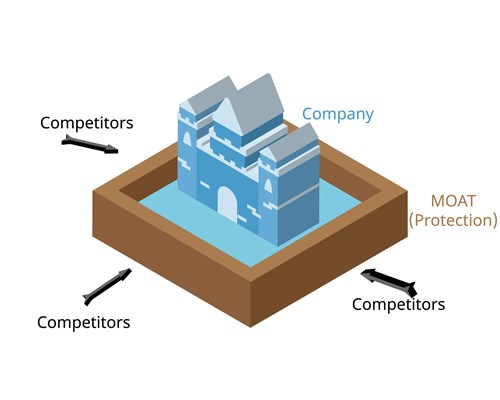Investors in scale-ups want to see IP strategies that create sustainable value. A patent portfolio on its own is not always enough – companies need to show how their IP is part of a broader plan to secure commercial success.
Building a moat as a defensive tactic was remarkably common across much of the old world. From ancient Egypt to medieval Europe and feudal Japan, moats were used to protect strategic positions and valuable assets from invaders.
The analogy of a moat in the business world was popularised in the 1980s by billionaire investor Warren Buffett. He suggested that in order to maintain a sustainable competitive advantage, a company needs to build a moat to protect its market position from competitors.
While this thinking is relevant to all companies, it’s particularly important for scale-ups seeking capital. Investors want to see a moat around where they’re putting their money, so scale-ups need to spend time on studying, creating and communicating their sustainable competitive advantage.
“To really understand and strengthen your moat, you need to deconstruct your offering into the various assets you have. When you understand your assets, you can see which ones are truly differentiating,” says Global Head of Rouse Consultancy, Tim Smith. “If you focus on controlling those assets that provide the greatest differentiation, you strengthen your moat and build longer-term value in your business.”
Putting IP at the core of your strategy
The assets used to build a moat come in many forms that can be controlled in different ways. One such form is intellectual property, the creation and protection of which can be extremely valuable – especially for technology companies.
But just as not all moats are built the same, neither is all IP created equal. A narrow moat – or weak IP with limited coverage – is not an effective defensive mechanism over time. It can be easy to circumvent or rapidly become obsolete. Contrast this with a wider moat, where IP has broader coverage and provides the strategic protection needed to create a significant market impact.
“Scale-ups and other companies are often advised to simply patent what is patentable, without thinking about the broader market context and their measure of control over it. This thinking comes from having a very narrow view on IP; perhaps only looking at it from the legal standpoint,” says Smith.
“But if you’ve got a broad view on IP, then you’re thinking about its function in the context of really controlling your position in the market. You need to contextualise your patents and other assets into a business model that delivers a sustainable competitive advantage – building that critical moat. This is what Rouse Consultancy helps companies to do,” he explains.
Know your assets, build your moat
Rouse Consultancy develops and brings together strategies in three overlapping areas: business, technology and control. The latter refers to using various tools – including IP, contract law, secrecy, employee retention and more – to build a market position and protect assets from competitors.
“Today there is so much value in intangible assets. These can be data pools, insights drawn from that data, algorithms, machine-learning principles, or classic technological solutions. If you only think narrowly about these assets – looking purely at what is patentable – then you’re going to miss out on opportunities to create value and build your moat,” observes Smith.
By helping companies to understand the value of the assets they have in different areas, Rouse Consultancy is a valuable partner in building IP strategies that support longer-term success.
“The reason you want a patent is because it gives you some control in a value chain. But all too often companies do not make the connection between their IP and this value. Patenting for the sake of patenting means you end up with an expensive portfolio that does not support your broader business strategy.”
“When you understand the relationship between your business, your technology and your degree of market control, then you can build the moat that ensures your sustainable competitive advantage,” says Smith.

For further information, please contact:
Tim Smith, Rouse
tsmith@rouse.com






